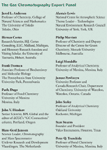Analysis of the State of the Art: Gas Chromatography
Special Issues
Recently LCGC asked a panel of experts (listed in the sidebar) to assess the current state of the art of gas chromatography (GC) instrumentation and methods and to try to predict how the technology will develop in the future.
Recently LCGC asked a panel of experts (listed in the sidebar) to assess the current state of the art of gas chromatography (GC) instrumentation and methods and to try to predict how the technology will develop in the future. Here are some highlights from that discussion.

The Gas Chromatography Expert Panel
The Future of Fast GC
We started by asking our expert panel about some of the latest methods, including fast GC. All our experts agree that the future for fast GC is bright. Naturally, chromatographers would like to get their results faster with lower consumption of carrier and detector gas. Also, fast GC is synergistic with the shift from helium to hydrogen carrier gas, and it can increase overall sample throughput. This speed is particularly valuable in applications like high-throughput screening.
The main route toward faster GC analysis, note Paola Dugo, Luigi Mondello, and Peter Q. Tranchida, is to use microbore capillaries. Such an approach is readily accessible, because most commercially available GC systems can provide the required instrument performance needed when using such columns. Also, microbore capillaries with a 0.1-mm internal diameter are now available with a wide variety of stationary phases. "All this means that it is now possible to shorten analyses times by a factor of 4–5 times, with no price to pay in terms of resolution," they say.
But there are challenges with fast GC, notes John Hinshaw. For example, the instrumentation must present the column with fast enough injection speeds and rapid column oven program rates while capturing the resulting fast peaks. Also, existing methods must be translated to preserve peak order, and they still may require revalidation. Lastly, he says, narrow-bore thinner-film columns may have reduced sample capacities and injection-volume limits that require adjusted sample concentrations and volumes.
Fast GC can also get bogged down by slow sample preparation or delays in cooling the oven at the end of the run. "There's no point in a 2-min fast GC run if it is accompanied by a 6-min oven cool down," says Alastair Lewis. This points the way, he says, toward resistively heated columns, but with really low thermal masses. "The annual energy savings for labs could turn out to be the clincher here, rather than better analytical capability."
Nor will fast GC solve problems of poor resolution, notes Frank Dorman. "Fast GC really needs to be coupled with the optimization of the other GC parameters, most notably the selectivity of the stationary phase," he says. "This is especially true for targeted separations, which is where more of the fast GC applications have been directed." So he predicts that fast GC will remain a niche technique for the short term. "But that could change if we move away from 30-m fused-silica columns," he adds.
Hans-Gerd Janssen argues that there is not that much need for fast GC. A standard GC run including cooling, reconditioning, and cleaning the syringe rarely takes more than 45 min, he points out, which means at least 30 unattended runs can be done in one day. "For most laboratories, that is enough and more than the analyst can handle in sample preparation and interpretation," he says. "Also, there are not many laboratories that need a short time between arrival of the sample in the laboratory and the results being available."
Two-Dimensional GC
We also asked our experts about another emerging method, comprehensive two-dimensional (2D) GC (GC×GC). Will this technique become the norm for the analysis of volatile compounds, we wondered?
Our experts generally agree that GC×GC is extremely powerful, but unlikely to become a mainstream method in the near future. "Issues such as high instrument costs, use of cryogenic gases, and optimization difficulties inhibit the widespread and routine use of this approach," say Dugo, Mondello, and Tranchida.
John Seeley agrees. "In GC×GC, initial runs often produce a nearly unrecognizable 2D chromatogram and the appropriate changes to the run conditions require both an understanding of the GC×GC technique and knowledge of the sample mixture," he says. "I'm not sure that there is widespread commitment by the community to take the time to become proficient in the use of GC×GC."
Perhaps just as important, the resolving power of 2D GC often is not necessary. "In many cases, typical problems can be solved with conventional GC technology, and this will continue to be the norm," says Hernan Cortes.
As a result, says Hinshaw, GC×GC will remain limited to complex or difficult separations in which two orthogonal separation chemistries are required to fully pull apart a mixture.
But for such analyses, says Dorman, GC×GC usage will grow. He points out that current commercial GC×GC systems are quite robust, often with software that is fully integrated with the hardware, making these instruments capable of routine analysis. "The technique is still viewed by many as a niche, but each year, more practitioners are realizing that GC×GC is no longer a 'research tool' only," he concludes.
Philip Marriott, who considers himself a proponent of comprehensive 2D GC, would like to see it play a wider role in the chemical analysis of volatile samples, but doesn't expect that to happen quickly. "Few standard methods of analysis describe dedicated GC×GC protocols, and these take a long time to develop," he says. "It would be interesting if a reviewer (or even a judge) were to call into question the chemical analysis of a volatile sample if only 1D GC was used, and proposed or required that a GC×GC method should be the logical methodology!"
Stan Stearns is more optimistic about the expansion of the method. "Comprehensive GC will grow as users realize how much simpler multidimensional systems can be than current GC methods," he says. For example, he says, the analysis of trace impurities in ultrapure gases is routinely accomplished by the use of valves to divert unresolved components into separate columns for determination at the part-per-billion level. "Partial modulation has been shown to provide a simple alternative to the many complex multidimensional systems requiring off-line valves and electronic pressure controls," he points out.
Janssen agrees, and believes 2D GC methods will become the norm, and not just for volatile compounds. "Comprehensive GC×GC is getting easier to do," he says. "So rather than occasionally using heartcut 2D GC only if everything else fails, comprehensive GC×GC will be done for all samples." He also believes GC×GC is a good solution for laboratories that need flexibility. "Because of the very high separation power of 2D GC, many different applications previously requiring different columns can now be done on one GC×GC instrument with one column set."
The Future of Field-Portable Gas Chromatographs
Field-portable GC instruments offer great advantages, particularly for applications such as homeland security and the emergency response to environmental disasters. In addition to improving speed and sample robustness, "taking the laboratory into the field" also dramatically decreases the overall cost of an analysis. But a limited number of samples are amenable to field analysis, and field-portable instrumentation has historically given up a lot of analytical power relative to its fixed-laboratory counterparts.
"Ease of use, ruggedness, and price [of field-portable GC instruments] are all acceptable, but better performance in terms of numbers of plates and an easier method to change the selectivity of the systems are needed," says Janssen. "Instruments are needed that provide separation powers similar to that of laboratory instruments, with easy methods to change and replace columns.
But some believe the performance differences between laboratory and field systems can be reduced. "With more advances in micromachining and microelectrical mechanical systems, it is likely that this gap will be narrowed, making field instruments capable of fixed lab method compliance," says Dorman. And once the analytical power of field instruments approaches that of fixed lab instruments, he says, the throughput advantage will drive more separations to these devices.
Improving detectors will also aid in this process. "As systems become smaller and faster and are combined with selective detectors, particularly compact mass spectrometers, their use will expand," says Stearns.
Some also foresee growth in field-deployable systems not just for emergencies, but for routine monitoring.
The Messina group holds a contrarian view, generally preferring the option of fast and effective field sampling, rather than analysis in the field, and notes that great advances have been made in the sample preparation field over the past two decades. "Essentially, it is preferable to bring the sample to the GC–MS system, instead of the opposite," they say.

Study Examines Impact of Zwitterionic Liquid Structures on Volatile Carboxylic Acid Separation in GC
March 28th 2025Iowa State University researchers evaluated imidazolium-based ZILs with sulfonate and triflimide anions to understand the influence of ZILs’ chemical structures on polar analyte separation.








